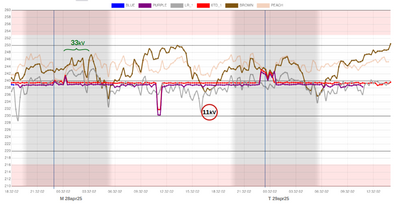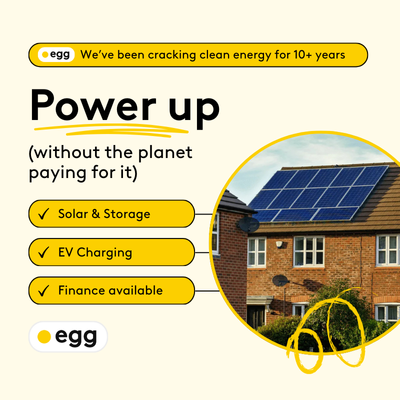Battery storage to run Heat Pump.
@jamespa jumping on this thread late, and I'm of a similar opinion to you, I've been getting quotes every few years for a battery.
The payback has gone from none whatsoever, to marginal. Prices have stayed fairly static, while capacity (including depth of discharge), power, warranty and safety have improved, so better value overall.
I'm hopeful that the newer Sodium Ion chemistry launched by BYD for their small affordable domestic car market may soon find it's way into stationery battery storage.
In theory that could mark the point at which home batteries become really affordable, even safer, and work in the cold without heaters etc. 🤞
Posted by: @scalextrix@jamespa jumping on this thread late, and I'm of a similar opinion to you, I've been getting quotes every few years for a battery.
The payback has gone from none whatsoever, to marginal. Prices have stayed fairly static, while capacity (including depth of discharge), power, warranty and safety have improved, so better value overall.
I'm hopeful that the newer Sodium Ion chemistry launched by BYD for their small affordable domestic car market may soon find it's way into stationery battery storage.
In theory that could mark the point at which home batteries become really affordable, even safer, and work in the cold without heaters etc. 🤞
Im also hopeful that prices will come down but it does seem very slow. Im currently getting a quote once more, but its still working out at £400-500/kWh installed, which is still too much once you account for loss of interest on the capital, and tax on the revenue from arbitrage (sorry but I don't like building a business case on an assumption of tax avoidance)
Im also hopeful that bi directional EV chargers will return to the market, so I can replace our second car, a petrol Fiesta which spends almost all of its life on the driveway, with an aging Nissan Leaf that then doubles as a massive home storage battery.
Finally there is another revenue stream which Capture Energy are beginning to tout and Octopus will surely offer. If you can guarantee availability to either consume or produce 1MW or above, you can be paid an availability fee by the grid for flexibility, and a further fee if that flexibility is actually used. Individuals obviously cant do this, but 'virtual power companies' can, by aggregating many consumer sources. Sharing the revenue from this with the virtual power company provides an additional income stream which has the potential to help with the business case.
its very interesting times for sure
4kW peak of solar PV since 2011; EV and a 1930s house which has been partially renovated to improve its efficiency. 7kW Vaillant heat pump.
Posted by: @scalextrixI'm hopeful that the newer Sodium Ion chemistry launched by BYD for their small affordable domestic car market may soon find it's way into stationery battery storage.
I would be surprised if the battery chemistry is going to be a major factor in your viability assessment.
The major costs are
- installation time, incl tooling
- the inverter(s), cabling, safety trips etc
- training, certification, insurance & warranties
Let's combine this observation with the next comment from James:
Posted by: @jamesparevenue stream which Capture Energy are beginning to tout and Octopus will surely offer. If you can guarantee availability to either consume or produce 1MW or above, you can be paid an availability fee by the grid for flexibility
This is therefore an attractive path to be taken by local Community Energy groups.
The RIIO-ED2 Agreements between DNOs and Ofgem all have variations, but they do contain financial incentives for DNOs to
- engage with, and provide support to Community Energy initiatives
- offer flexibility-services
But DNOs may not own or control generation or storage assets.
They would, however, be 'interested' in Community Groups who could get their act together and do their own low-cost (semi-DIY) battery installations.
The more widespread were those storage batteries, the greater flexibility could be 'offered' back to that DNO.
The three key issues they're interested in are:
- absorbing excess-generation from renewable generation sites in the area (typically connected at 11kV or 33kV)
- time-slicing use of the (extensive) 11kV network so as to better use its available capacity over each day/night
- varying the charge current being taken from the grid such that losses due to phase-imbalance are progressively reduced
OK... so that requires a bit of grid monitoring, but not as much as you might suppose.
If I have LV monitors on several different 11kV (rural) feeds from a Primary Substation, I can detect which fluctuations are constrained to each feed,
and which are due to effects at the area-wide 33kV level:
Ignore the red & purple traces - they're being manually controlled.
The voltage rises/falls between 00:30 and 03:30 are area-wide because they affect Brown, Grey and Peach locations equally.
In contrast, the sudden dip detected at 16:15 by the grey monitor is peculiar to that Feed.
So why don't we see this approach being implemented across multiple community-installed storage batteries to offer flexibility services?
- there's no revenue stream which could be harnessed to make a profit for anyone
- there's no Nodal-Tariffs available to pay the storage battery owners
- DESNZ seem to think that Zonal-Tariffs would operate according to political boundaries, irrespective of how the grid actually works
- the Secretary of State for ESNZ has twice changed his mind on introducing sub-national tariff structures in the first half of 2025, partly under pressure from No.10
- there's no Innovation Funding available for developing solutions based on 'concepts'; there must be a 'product' which can be assessed for commercial viability
- if we don't implement flexibility-services using distributed mass-storage, then grid infrastructure requires massive upgrades... which equates to long-term profits for DNOs
I can cope with the technological parts of the conundrum...
... it's the politics and shareholders' profits which frustrate me!
Save energy... recycle electrons!
Currently viewing this topic 1 user ( Sheriff Fatman ) and 2 guests.
Recently viewed by users: Majordennisbloodnok 26 minutes ago, Gary 40 minutes ago, Transparent 14 minutes ago.
- 22 Forums
- 2,087 Topics
- 46 K Posts
- 20 Online
- 3,379 Members
Trusted Installers
Struggling to find a reliable heat pump installer? A poor installation can lead to inefficiencies and high running costs. We now connect homeowners with top-rated installers who deliver quality work and excellent service.
✅ Verified, trusted & experienced installers
✅ Nationwide coverage expanding
✅ Special offers available
Latest Posts
-

I would be wary, @pie_eater. Using liquid to cool means...
By Majordennisbloodnok , 20 minutes ago
-

My advice is reject unless they will delete the buffer ...
By JamesPa , 1 hour ago
-

RE: When will heat pumps and install prices come down?
I agree. My EV, solar panels and heat pump are basical...
By JamesPa , 1 hour ago
-

RE: Battery storage to run Heat Pump.
I would be surprised if the battery chemistry is going ...
By Transparent , 3 hours ago
-

I went on Wednesday. It was definitely and interesting ...
By JamesPa , 6 hours ago
-

RE: Commencing on an ASHP Installation Process
And on the second day, we have a completed installation...
By Sheriff Fatman , 18 hours ago
-

RE: Mitsubishi Ecodan Fails to Heat Water despite temperature drop
Its the flow temperature for the heating circuit, it me...
By Gary , 19 hours ago
-

RE: Air source heat pump roll call – what heat pump brand and model do you have?
@dowallydrifter OK. I would recommend you read t...
By JamesPa , 20 hours ago
-

RE: Solar to power Heat Pump for DHW
Wow, how big is your heat pump that it is pulling 6kW d...
By Old_Scientist , 1 day ago
-

Adding battery storage to SolarEdge PV system
Hi, I think I've narrowed down my choice to a Sunsynk 5...
By nazuro1041 , 1 day ago
-

There are DHW tanks with a built in heat pump that take...
By JamesPa , 2 days ago
-

RE: Vaillant AroTherm Plus 7kW
If the thermostat is connected to the call for heat ter...
By JamesPa , 2 days ago
-

RE: Renewables & Heat Pumps in the News
Yes I realise I'm picking this up a week late...... but...
By Transparent , 3 days ago
-

RE: Surface mount or bury primaries for heat pump installation?
@tomasmcguinness HI, The rules is a best practise, the ...
By ASHP-BOBBA , 4 days ago
-

RE: Getting the best out of a heat pump - is Homely a possible answer?
@cathoderay how did you get a script to run for that- d...
By benson , 4 days ago
-

RE: Renewable Heating Hub Homeowners' Q&A Podcast
@ashp-bobba thank you, and equally so, thank you for ta...
By Mars , 5 days ago
-

@judith good to know… I’ll continue to feed Wattson, an...
By Mars , 6 days ago





